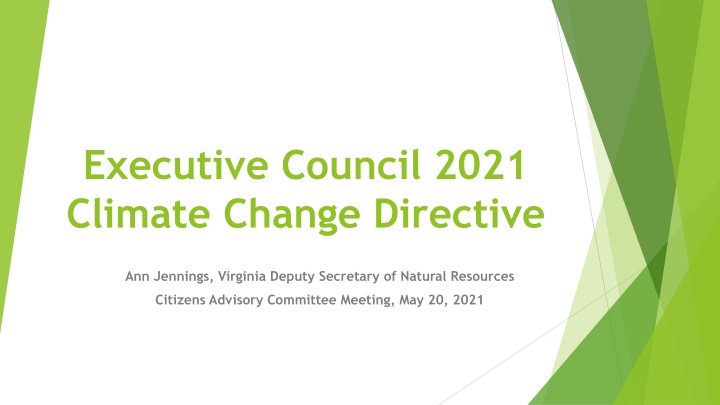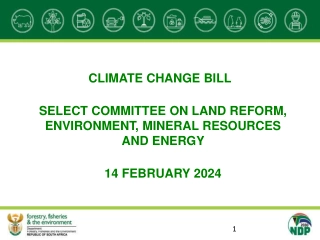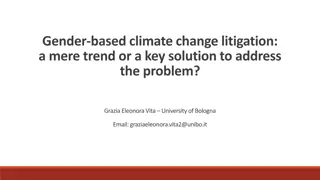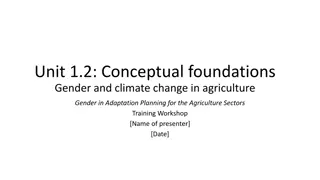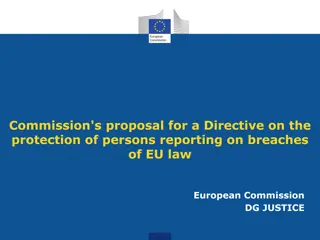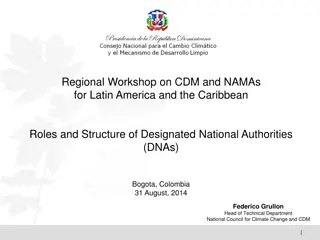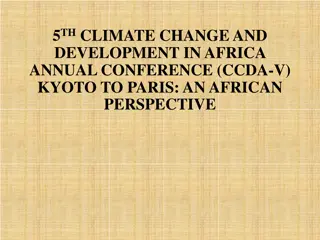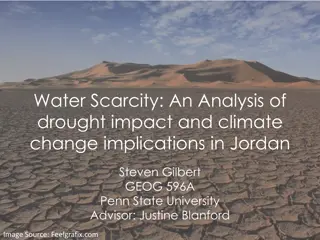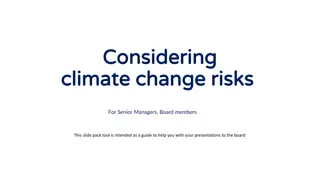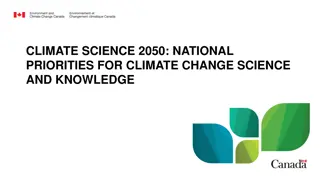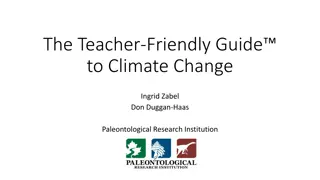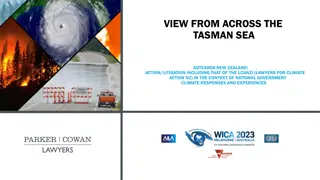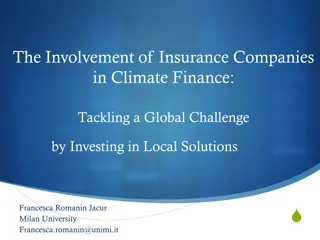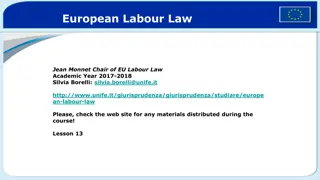Executive Council 2021 Climate Change Directive Overview
This content provides insights into the Executive Council's 2021 Climate Change Directive, highlighting key actions, prior initiatives, and strategies for enhancing climate resiliency in the Chesapeake Bay watershed. It covers topics such as monitoring impacts, adaptation measures, and the effects of climate change on the region's ecosystem and infrastructure.
Download Presentation

Please find below an Image/Link to download the presentation.
The content on the website is provided AS IS for your information and personal use only. It may not be sold, licensed, or shared on other websites without obtaining consent from the author.If you encounter any issues during the download, it is possible that the publisher has removed the file from their server.
You are allowed to download the files provided on this website for personal or commercial use, subject to the condition that they are used lawfully. All files are the property of their respective owners.
The content on the website is provided AS IS for your information and personal use only. It may not be sold, licensed, or shared on other websites without obtaining consent from the author.
E N D
Presentation Transcript
Executive Council 2021 Climate Change Directive Ann Jennings, Virginia Deputy Secretary of Natural Resources Citizens Advisory Committee Meeting, May 20, 2021
Overview: 2014 EC Statement on Climate Change; More Recent Findings/Actions on Climate Change Charge from the Principals Staff Committee Climate Change Action Team Members Review Final Draft Executive Council 2021 Climate Change Directive Next Steps
Prior EC Action on Climate Change 2014 Chesapeake Bay Watershed Agreement CLIMATE RESILIENCY Changing climatic and sea level conditions may alter the Bay ecosystem and human activities, requiring adjustment to policies, programs and projects to successfully achieve our restoration and protection goals for the Chesapeake Bay and its watershed. This challenge requires careful monitoring and assessment of these impacts and application of this knowledge to policies, programs and projects. GOAL: Increase the resiliency of the Chesapeake Bay watershed, including its living resources, habitats, public infrastructure and communities, to withstand adverse impacts from changing environmental and climate conditions. Monitoring and Assessment Outcome Continually monitor and assess the trends and likely impacts of changing climatic and sea level conditions on the Chesapeake Bay ecosystem, including the effectiveness of restoration and protection policies, programs and projects. Adaptation Outcome Continually pursue, design and construct restoration and protection projects to enhance the resiliency of Bay and aquatic ecosystems from the impacts of coastal erosion, coastal flooding, more intense and more frequent storms and sea level rise.
Climate Resiliency Outcomes Management Strategy 2015 2025, v.1 All aspects of life in the Chesapeake Bay watershed from living resources to public health, from habitat to infrastructure are at risk from the effects of a changing climate. As one of the most vulnerable regions in the nation, the Chesapeake Bay is expected to experience major shifts in environmental conditions. Warming temperatures, rising sea levels and more extreme weather events have already been observed in the region, along with coastal flooding, eroding shorelines and changes in the abundance and migration patterns of wildlife.
CLIMATE CHANGE IMPACTS ON CHESAPEAKE BAY: A WORLD WATER DAY PRESENTATION BY UMCES PRESIDENT PETER GOODWIN The Chesapeake Bay, at over 165,000 square kilometers it is the largest estuary in the Americas. The watershed consists of six states and Washington, D.C. It is unique for its size, small tidal range, and shallowness. All these factors combined make it particularly vulnerable to climate change March 22, 2020
President Bidens Executive Order: Tackling the Climate Crisis at Home and Abroad The United States and the world face a profound climate crisis. We have a narrow moment to pursue action at home and abroad in order to avoid the most catastrophic impacts of that crisis and to seize the opportunity that tackling climate change presents. The scientific community has made clear that the scale and speed of necessary action is greater than previously believed. There is little time left to avoid setting the world on a dangerous, potentially catastrophic, climate trajectory.
Components of Climate Change Effect on Tidal Dissolved Oxygen Chesapeake Bay Program Science, Restoration, Partnership 7
PSC Charge to the Climate Change Action Team Communicate an EC position that confirms and reinforces the current science-based understanding that climate change is causing severe detrimental impacts on the Chesapeake Bay and its watershed communities and natural resources - and urgent attention is warranted. Update the EC position on climate change by preparing a new Executive Council Directive.
Climate Change Action Team Members Chris Brosch Delaware Program Administrator, Delaware Dept. of Agriculture Lauren Townley New York Chief, Watershed Section A, NYS DEC, Division of Water John Maleri DC Environmental Protection Specialist, DOEE, Watershed Protection Division Adrienne Kotula CBC Virginia Director Teresa Koon West Virginia Assistant Director, WV DEP Division of Water and Waste Management Mark Bennett USGS/Fed. Govt. Center Director, Virginia and West Virginia Water Science Center Suzanne Dorsey Maryland MDE Assistant Secretary Josh Lookenbill Pennsylvania Acting Co-Director of the DEP Bureau of Clean Water Michael Dunn EPA/Fed. Govt. Acting Chief of Staff, Region 3 Administrator Ann Jennings Virginia Deputy Secretary of Natural Resources
Preparing the Draft Executive Directive Guiding Principles Respect jurisdictional differences in responses to climate change and impacts of climate change on local communities. Prioritize the response to climate change for vulnerable populations, underserved communities and working lands (farms and forests). Recognize that water quality best management practices sequester carbon and climate mitigation measures reduce nitrogen pollution. Focus on adaptation, resilience and mitigation and the co-benefits provided by water quality measures and habitat restoration. Maintain focus on the work of the Chesapeake Bay Program. Embed the partnership s response to climate change throughout the program. Don t duplicate climate work by the jurisdictions or other federal programs. Ensure the Chesapeake Bay Program partnership s flagship scientific endeavors are informed by the most advanced climate monitoring, tools, science, and practice standards. Recognize that delayed action on climate change will increase the cost of restoring the Chesapeake Bay. Continue to educate, learn, adapt and innovate.
The Chesapeake Bay Executive Council Commits To: Address the threats of climate change in all aspects of the partnership s work to restore the Bay and its watershed; Prioritize communities, working lands, and habitats most vulnerable to ever- increasing risks; Apply the best scientific, modeling, monitoring and planning capabilities of the Bay Program; and, Connect Chesapeake Bay restoration outcomes with emerging opportunities in climate adaptation, mitigation, and resilience.
Address the threats of climate change in all aspects of the partnership s work to restore the Chesapeake Bay and its watershed Integrate climate science and adaptation to climate change throughout the work of the Chesapeake Bay Program partnership, and direct the Management Board to ensure the partnership s organizational structure effectively advances this integration. Direct the Management Board to incorporate climate risks into the managementstrategies of the 2014 Chesapeake Bay Watershed Agreement outcomes. Ensure the science, restoration and partnership programs equitably address the impacts of climate change on vulnerable populations, including indigenous people, historically underrepresented communities, those of lower economic status, and people of color, taking into account existing social, economic, and health disparities. Continuously improve our knowledge of and response to the threats of climate change and report on implementation of this Executive Directive and new challenges at Chesapeake Executive Council annual meetings.
Prioritize communities and habitats most vulnerable to ever-increasing risks Emphasize the continued need to update best management practice design standards to account for the impacts of climate change, using leading predictive models and tools, to insure investments made today continue to yield benefits even as the climate changes. Ensure that we focus on achieving our outcomes to conserve and restore wetlands, forest buffers and urban tree canopies for both increased resilience to climate impacts and to assist in meeting national goals for achieving 30 percent of lands and waters conserved by 2030. Build climate science into environmental literacy programs for students, the public, and decision-makers ensuring inclusion of the most vulnerable habitats, people, communities and industries.
Apply the best scientific, modeling, monitoring and planning capabilities of the Chesapeake Bay Program Determine capacity needed to monitor the impacts of climate change on our natural resources within the existing Chesapeake Bay Program partnership s science programs and evaluate the opportunity to fill those needs with ongoing climate change monitoring programs. Improve the Chesapeake Assessment Scenario Tool cost calculator to account for climate change so that the partnership can ensure investments in water quality take into account the impacts of delayed action.
Connect Chesapeake Bay restoration goals with emerging opportunities in climate adaptation, mitigation, and resilience Recognize and, where feasible, assess and adopt the water quality practices that sequester greenhouse gases, and the climate mitigation practices that reduce nitrogen pollution to watersheds. Prioritize the adoption of farming and forestry best management practices to maximize the co-benefits of improved water quality, resilience, carbon sequestration, and soil health. Promote greenhouse gas mitigation through restoring coastal ecosystems and enhancing green infrastructure throughout the watershed. Utilize conservation finance where appropriate to leverage public and increase private investments, including emerging carbon markets, in Chesapeake Bay restoration.
Executive Council 2021 Climate Change Directive Next Steps for the PSC and EC Questions?
